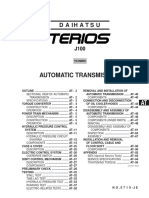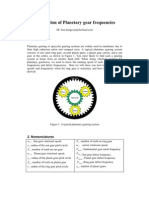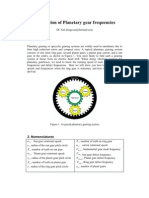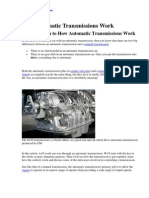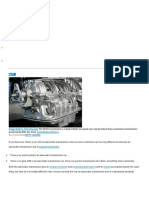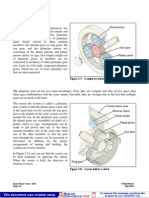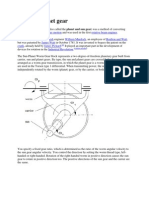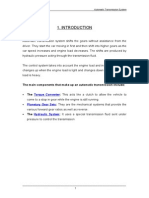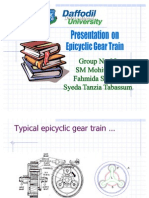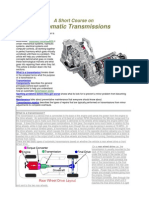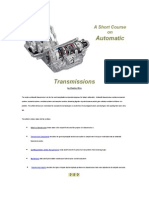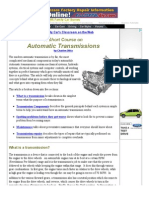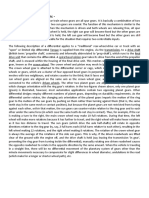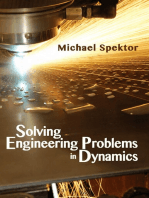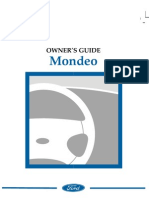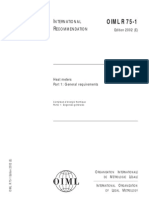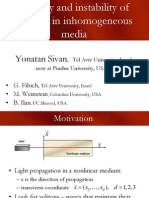How Stuff Works - How Automatic Transmissions Work
How Stuff Works - How Automatic Transmissions Work
Uploaded by
Kausik DattaCopyright:
Available Formats
How Stuff Works - How Automatic Transmissions Work
How Stuff Works - How Automatic Transmissions Work
Uploaded by
Kausik DattaOriginal Title
Copyright
Available Formats
Share this document
Did you find this document useful?
Is this content inappropriate?
Copyright:
Available Formats
How Stuff Works - How Automatic Transmissions Work
How Stuff Works - How Automatic Transmissions Work
Uploaded by
Kausik DattaCopyright:
Available Formats
Howstuffworks "How Automatic Transmissions Work"
HOW A MECHANICAL TRANSMISSION WORK
If you have ever driven a car with an automatic transmission, then you know that there are two big differences between an automatic transmission and manual transmission:
q q
There is no clutch pedal in an automatic transmission car There is no gear shift in an automatic transmission car. Once you put the transmission into Drive, everything else is automatic!
Both the automatic transmission (plus its torque converter) and a manual transmission (with its clutch) accomplish exactly the same thing, but they do it in totally different ways. It turns out that the way an automatic transmission does it is absolutely amazing! In this edition of HowStuffWorks we'll work our way through an automatic transmission. We'll start with the key to the whole system: planetary gearsets. Then we'll see how the transmission is put together, learn how the controls work and discuss some of the intricacies involved in controlling a transmission.
Figure 1 Location of the automatic transmission
Some Basics
Just like that of a manual transmission, the automatic transmission's primary job is to allow the engine to operate in its narrow range of speeds while providing a wide range of output speeds.
http://www.ingegneriameccanica.org/varie/automatic-transmission.htm (1 of 21)26/08/2011 9:53:55 AM
Howstuffworks "How Automatic Transmissions Work"
Without a transmission, cars would be limited to one gear ratio, and that ratio would have to be selected to allow the car to travel at the desired top speed. If you wanted a top speed of 80 mph, then the gear ratio would be similar to third gear in most manual transmission cars. You've probably never tried driving a manual transmission car using only third gear. If you did, you'd quickly find out that you had almost no acceleration when starting out, and, at high speeds, the engine would be screaming along near the red-line. A car like this would wear out very quickly and would be nearly undriveable. So the transmission uses gears to make more effective use of the engine's torque, and to keep the engine operating at an appropriate speed. The key difference between a manual and an automatic transmission is that the manual transmission locks and unlocks different sets of gears to the output shaft to achieve the various gear ratios, while in an automatic transmission, the same set of gears produces all of the different gear ratios. The planetary gearset is the device that makes this possible in an automatic transmission...
Planetary Gearsets
When you take apart and look inside an automatic transmission, you find an amazing assortment of parts in a fairly small space. Among other things you see:
q q q q q
An extremely ingenious planetary gearset A set of bands that lock parts of a gearset A set of 3 wet-plate clutches to lock other parts of the gearset An incredibly odd hydraulic control system that controls the clutches and bands A large gear pump to move transmission fluid around
The center of attention is the planetary gearset. About the size of a cantelope, this one part creates all of the different gear ratios that the transmission can produce. Everything else in the transmission is there to help the planetary gearset do its thing. This amazing piece of gearing has appeared on HowStuffWorks before. You may recognize it from the electric screwdriver article. An automatic transmission contains two complete planetary gearsets folded together into one component. See How Gear Ratios Work for an introduction to planetary gearsets.
http://www.ingegneriameccanica.org/varie/automatic-transmission.htm (2 of 21)26/08/2011 9:53:55 AM
Howstuffworks "How Automatic Transmissions Work"
From left to right: the ring gear, planet carrier, and two sun gears.
Any planetary gearset has three main components:
q q q
the sun gear the planet gears and the planet gears' carrier the ring gear.
Each of these three components can be the input, the output or can be held stationary. Choosing which piece plays which role determines the gear ratio for the gearset. Let's take a look at a single planetary gearset. One of the planetary gearsets from our transmission has a ring gear with 72 teeth and a sun gear with 30 teeth. We can get lots of different gear ratios out of this gearset. Input A Sun (S) Output Planet Carrier (C) Ring (R) Ring (R) Stationary Ring (R) Sun (S) Planet Carrier (C) Calculation Gear Ratio 1 + R/S 1 / (1 + S/R) -R/S 3.4:1 0.71:1 -2.4:1
B Planet Carrier (C) C Sun (S)
Also, locking any two of the three components together will lock up the whole device at a 1:1 gear reduction. Notice that the first gear ratio listed above is a reduction -- the output speed is slower than the input speed. The second is an overdrive -- the output speed is faster than the input speed. The last is a reduction again, but the output direction is reversed. There are several other ratios that can be gotten out of this planetary gear set, but these are the ones that are relevant to our automatic transmission. You can try these out in the animation below:
http://www.ingegneriameccanica.org/varie/automatic-transmission.htm (3 of 21)26/08/2011 9:53:55 AM
Howstuffworks "How Automatic Transmissions Work"
Figure 2 Animation of the different gear ratios related to automatic transmissions Click on the buttons on the left in the table above.
So this one set of gears can produce all of these different gear ratios without having to engage or disengage any other gears. With two of these gearsets in a row, we can get the four forward gears and one reverse gear our transmission needs. We'll put the two sets of gears together in the next section.
Gears
This automatic transmission uses a set of gears, called a compound planetary gearset, that looks like a single planetary gearset but actually behaves like two planetary gearsets combined. It has one ring gear that is always the output of the transmission, but it has two sun gears and two sets of planets. Let's look at some of the parts. Figure 3 shows how the gears in the transmission are put together.
http://www.ingegneriameccanica.org/varie/automatic-transmission.htm (4 of 21)26/08/2011 9:53:55 AM
Howstuffworks "How Automatic Transmissions Work"
Figure 3 From left to right: the ring gear, planet carrier, and two sun gears.
Figure 4 shows the planets in the planet carrier. Notice how the planet on the right sits lower than the planet on the left. The planet on the right does not engage the ring gear -- it engages the other planet. Only the planet on the left engages the ring gear.
Figure 4 Planet carrier: Note the two sets of planets.
Figure 5 shows the inside of the planet carrier. The shorter gears are engaged only by the smaller sun gear. The longer planets are engaged by the bigger sun gear and by the smaller planets.
http://www.ingegneriameccanica.org/varie/automatic-transmission.htm (5 of 21)26/08/2011 9:53:55 AM
Howstuffworks "How Automatic Transmissions Work"
Figure 5 Inside of the planet carrier: Note the two sets of planets.
Figure 6 shows all of the parts are hooked up in a transmission.
Figure 6 Move the shift lever to see how power is transmitted through the transmission.
http://www.ingegneriameccanica.org/varie/automatic-transmission.htm (6 of 21)26/08/2011 9:53:55 AM
Howstuffworks "How Automatic Transmissions Work"
First Gear
In first gear, the smaller sun gear is driven clockwise by the turbine in the torque converter. The planet carrier tries to spin counterclockwise, but is held still by the one-way clutch (which only allows rotation in the clockwise direction) and the ring gear turns the output. The small gear has 30 teeth and the ring gear has 72, so referring to the chart on the previous page, the gear ratio is: Ratio = -R/S = - 72/30 = -2.4:1 So the rotation is negative 2.4:1, which means that the output direction would be opposite the input direction. But the output direction is really the same as the input direction -- this is where the trick with the two sets of planets comes in. The first set of planets engages the second set, and the second set turns the ring gear; this combination reverses the direction. You can see that this would also cause the bigger sun gear to spin; but because that clutch is released, the bigger sun gear is free to spin in the opposite direction of the turbine (counterclockwise).
Second Gear
This transmission does something really neat in order to get the ratio needed for second gear. It acts like two planetary gearsets connected to each other with a common planet carrier. The first stage of the planet carrier actually uses the larger sun gear as the ring gear. So the first stage consists of the sun (the smaller sun gear), the planet carrier, and the ring (the larger sun gear). The input is the small sun gear; the ring gear (large sun gear) is held stationary by the band, and the output is the planet carrier. For this stage, with the sun as input, planet carrier as output, and the ring gear fixed, the formula is: 1 + R/S = 1 + 36/30 = 2.2:1 The planet carrier turns 2.2 times for each rotation of the sun gear. At the second stage, the planet carrier acts as the input for the second planetary gear set, the larger sun gear (which is held stationary) acts as the sun, and the ring gear acts as the output, so the gear ratio is: 1 / (1 + S/R) = 1 / (1 + 36/72) = 0.67:1 To get the overall reduction for second gear, we multiply the first stage by the second, 2.2 x 0.67, to get a 1.47:1 reduction. This may sound wacky, but it works.
Third Gear
Most automatic transmissions have a 1:1 ratio in third gear. You'll remember from the previous section that all we have to do to get a 1:1 output is lock together any two of the three parts of the planetary gear.
http://www.ingegneriameccanica.org/varie/automatic-transmission.htm (7 of 21)26/08/2011 9:53:55 AM
Howstuffworks "How Automatic Transmissions Work"
With the arrangement in this gearset it is even easier -- all we have to do is engage the clutches that lock each of the sun gears to the turbine. If both sun gears turn in the same direction, the planet gears lockup because they can only spin in opposite directions. This locks the ring gear to the planets and causes everything to spin as a unit, producing a 1:1 ratio.
Overdrive
By definition, an overdrive has a faster output speed than input speed. It's a speed increase -- the opposite of a reduction. In this transmission, engaging the overdrive accomplishes two things at once. If you read How Torque Converters Work, you learned about lockup torque converters. In order to improve efficiency, some cars have a mechanism that locks up the torque converter so that the output of the engine goes straight to the transmission. In this transmission, when overdrive is engaged, a shaft that is attached to the housing of the torque converter (which is bolted to the flywheel of the engine) is connected by clutch to the planet carrier. The small sun gear freewheels, and the larger sun gear is held by the overdrive band. Nothing is connected to the turbine; the only input comes from the converter housing. Let's go back to our chart again, this time with the planet carrier for input, the sun gear fixed and the ring gear for output. Ratio = 1 / (1 + S/R) = 1 / ( 1 + 36/72) = 0.67:1 So the output spins once for every two-thirds of a rotation of the engine. If the engine is turning at 2000 rotations per minute (RPM), the output speed is 3000 RPM. This allows cars to drive at freeway speed while the engine speed stays nice and slow.
Reverse
Reverse is very similar to first gear, except that instead of the small sun gear being driven by the torque converter turbine, the bigger sun gear is driven, and the small one freewheels in the opposite direction. The planet carrier is held by the reverse band to the housing. So, according to our equations from the last page, we have: Ratio = -R/S = 72/36 = 2.0:1 So the ratio in reverse is a little less than first gear in this transmission.
Gear Ratios
This transmission has four forward gears and one reverse gear. Let's summarize the gear ratios, inputs and outputs:
http://www.ingegneriameccanica.org/varie/automatic-transmission.htm (8 of 21)26/08/2011 9:53:55 AM
Howstuffworks "How Automatic Transmissions Work"
Gear 1st
Input 30 tooth sun 30 tooth sun
Output 72 tooth ring Planet Carrier 72 tooth ring
Fixed Planet Carrier 36 tooth ring 36 tooth sun Total 2nd gear
Gear Ratio 2.4:1 2.2:1 0.67:1 1.47:1 1.0:1
2nd
Planet Carrier
3rd OD Reverse
30 and 36 tooth suns Planet Carrier 36 tooth sun
72 tooth ring 72 tooth ring 72 tooth ring 36 tooth sun Planet Carrier
0.67:1 -2.0:1
After reading this section, you are probably wondering how the different inputs get connected and disconnected. This is done by a series of clutches and bands inside the transmission. In the next section, we'll see how these work.
The Clutches and Bands
In the last section, we discussed how each of the gear ratios is created by the transmission. For instance, when we discussed overdrive, we said: In this transmission, when overdrive is engaged, a shaft that is attached to the housing of the torque converter (which is bolted to the flywheel of the engine) is connected by clutch to the planet carrier. The small sun gear freewheels, and the larger sun gear is held by the overdrive band. Nothing is connected to the turbine; the only input comes from the converter housing. To get the transmission into overdrive, lots of things have to be connected and disconnected by clutches and bands. The planet carrier gets connected to the torque converter housing by a clutch. The small sun gets disconnected from the turbine by a clutch so that it can freewheel. The big sun gear is held to the housing by a band so that it could not rotate. Each gear shift triggers a series of events like these, with different clutches and bands engaging and disengaging. Let's take a look at a band.
Bands
In this transmission there are two bands. The bands in a transmission are, literally, steel bands that wrap around sections of the gear train and connect to the housing. They are actuated by hydraulic cylinders inside the case of the transmission.
http://www.ingegneriameccanica.org/varie/automatic-transmission.htm (9 of 21)26/08/2011 9:53:55 AM
Howstuffworks "How Automatic Transmissions Work"
Figure 7 One of the bands
In Figure 7 you can see one of the bands in the housing of the transmission. The geartrain is removed. The metal rod is connected to the piston, which actuates the band.
Figure 8
http://www.ingegneriameccanica.org/varie/automatic-transmission.htm (10 of 21)26/08/2011 9:53:55 AM
Howstuffworks "How Automatic Transmissions Work"
The pistons that actuate the bands are visible above.
In Figure 8 you can see the two pistons that actuate the bands. Hydraulic pressure, routed into the cylinder by a set of valves, causes the pistons to push on the bands, locking that part of the gear train to the housing.
Clutches
The clutches in the transmission are a little more complex. In this transmission there are four clutches. Each clutch is actuated by pressurized hydraulic fluid that enters a piston inside the clutch. Springs make sure that the clutch releases when the pressure is reduced. Figure 9 shows the piston and the clutch drum. Notice the rubber seal on the piston -- this is one of the components that is replaced when your transmission gets rebuilt.
Figure 9 One of the clutches in a transmission
Figure 10 shows the alternating layers of clutch friction material and steel plates. The friction material is splined on the inside, where it locks to one of the gears. The steel plate is splined on the outside, where it locks to the clutch housing. These clutch plates are also replaced when the transmission is rebuilt.
http://www.ingegneriameccanica.org/varie/automatic-transmission.htm (11 of 21)26/08/2011 9:53:55 AM
Howstuffworks "How Automatic Transmissions Work"
Figure 10 The clutch plates
The pressure for the clutches is fed through passageways in the shafts. The hydraulic system controls which clutches and bands are energized at any given moment.
When You Put the Car in Park
It may seem like a simple thing to lock the transmission and keep it from spinning; but there are actually some complex requirements for this mechanism:
q
q q
You have to be able to disengage it when the car is on a hill (the weight of the car is resting on the mechanism). You have to be able to engage the mechanism even if the lever does not line up with the gear. Once engaged, something has to prevent the lever from popping up and disengaging.
The mechanism that does all this is pretty neat. Let's look at some of the parts first.
http://www.ingegneriameccanica.org/varie/automatic-transmission.htm (12 of 21)26/08/2011 9:53:55 AM
Howstuffworks "How Automatic Transmissions Work"
Figure 11 The output of the transmission The square notches are engaged by the parking-brake mechanism to hold the car still.
Figure 11 shows the output section of the transmission. The parking-brake mechanism engages the teeth on the output to hold the car still. This is the section of the transmission that hooks up to the driveshaft -so if this part can't spin, the car can't move.
Figure 12 The empty housing of the transmission with the parking brake mechanism poking through, as it does when the car is in park
Figure 12 shows the park mechanism protruding into the housing where the gears are located. Notice that it has tapered sides. This helps to disengage the parking brake when you are parked on a hill -- the force from the weight of the car helps to push the parking mechanism out of place because of the angle of the taper.
http://www.ingegneriameccanica.org/varie/automatic-transmission.htm (13 of 21)26/08/2011 9:53:55 AM
Howstuffworks "How Automatic Transmissions Work"
Figure 13 This rod actuates the park mechanism.
Figure 13 shows the rod that actuates the park mechanism. This rod is connected to a cable that is operated by the shift lever in your car.
http://www.ingegneriameccanica.org/varie/automatic-transmission.htm (14 of 21)26/08/2011 9:53:55 AM
Howstuffworks "How Automatic Transmissions Work"
Figure 14 The park mechanism
Figure 14 shows the park mechanism from the top. When the shift lever is placed in park, the rod pushes the spring against the small tapered bushing. If the park mechanism is lined up so that it can drop into one of the notches in the output gear section, the tapered bushing will push the mechanism down. If the mechanism is lined up on one of the high spots on the output, then the spring will push on the tapered bushing, but the lever will not lock into place until the car rolls a little and the teeth line up properly. This is why sometimes your car moves a little bit after you put it in park and release the brake pedal -- it has to roll a little for the teeth to line up to where the parking mechanism can drop into place. Once the car is safely in park, the bushing holds down the lever so that the car will not pop out of park if it is on a hill.
The Hydraulic System
The automatic transmission in your car has to do numerous tasks. You may not realize how many different ways it operates. For instance, here are some of the features of an automatic transmission:
q
q q q
If the car is in overdrive (on a four-speed transmission), the transmission will automatically select the gear based on vehicle speed and throttle pedal position. If you accelerate gently, shifts will occur at lower speeds than if you accelerate at full throttle. If you floor the gas pedal, the transmission will downshift to the next lower gear. If you move the shift selector to a lower gear, the transmission will downshift unless the car is going too fast for that gear. If the car is going too fast, it will wait until the car slows down and then downshift. If you put the transmission in second gear, it will never downshift or upshift out of second, even from a complete stop, unless you move the shift lever.
http://www.ingegneriameccanica.org/varie/automatic-transmission.htm (15 of 21)26/08/2011 9:53:55 AM
Howstuffworks "How Automatic Transmissions Work"
Figure 15
You've probably seen something that looks like Figure 15 before. It is really the brain of the automatic transmission, managing all of these functions and more. The passageways you can see route fluid to all the different components in the transmission. Passageways molded into the metal are an efficient way to route fluid; without them, many hoses would be needed to connect the various parts of the transmission. First, we'll discuss the key components of the hydraulic system; then we'll see how they work together.
The Pump
Automatic transmissions have a neat pump, called a gear pump. The pump is usually located in the cover of the transmission. It draws fluid from a sump in the bottom of the transmission and feeds it to the hydraulic system. It also feeds the transmission cooler and the torque converter.
http://www.ingegneriameccanica.org/varie/automatic-transmission.htm (16 of 21)26/08/2011 9:53:55 AM
Howstuffworks "How Automatic Transmissions Work"
Figure 16 Gear pump from an automatic transmission
The inner gear of the pump hooks up to the housing of the torque converter, so it spins at the same speed
http://www.ingegneriameccanica.org/varie/automatic-transmission.htm (17 of 21)26/08/2011 9:53:56 AM
Howstuffworks "How Automatic Transmissions Work"
as the engine. The outer gear is turned by the inner gear, and as the gears rotate, fluid is drawn up from the sump on one side of the crescent and forced out into the hydraulic system on the other side.
The Governor
The governor is a clever valve that tells the transmission how fast the car is going. It is connected to the output, so the faster the car moves, the faster the governor spins. Inside the governor is a springloaded valve that opens in proportion to how fast the governor is spinning -- the faster the governor spins, the more the valve opens. Fluid from the pump is fed to the governor through the output shaft. The faster the car goes, the more the governor valve opens and the higher the pressure of the fluid it lets through.
Figure 17 The governor
Throttle Valve or Modulator
To shift properly, the automatic transmission has to know how hard the engine is working. There are two different ways that this is done. Some cars have a simple cable linkage connected to a throttle valve in the transmission. The further the gas pedal is pressed, the more pressure is put on the throttle valve. Other cars use a vacuum modulator to apply pressure to the throttle valve. The modulator senses the manifold pressure, which drops when the engine is under a greater load.
Manual Valve
The manual valve is what the shift lever hooks up to. Depending on which gear is selected, the manual
http://www.ingegneriameccanica.org/varie/automatic-transmission.htm (18 of 21)26/08/2011 9:53:56 AM
Howstuffworks "How Automatic Transmissions Work"
valve feeds hydraulic circuits that inhibit certain gears. For instance, if the shift lever is in third gear, it feeds a circuit that prevents overdrive from engaging.
Shift Valves
Shift valves supply hydraulic pressure to the clutches and bands to engage each gear. The valve body of the transmission contains several shift valves. The shift valve determines when to shift from one gear to the next. For instance, the 1 to 2 shift valve determines when to shift from first to second gear. The shift valve is pressurized with fluid from the governor on one side, and the throttle valve on the other. They are supplied with fluid by the pump, and they route that fluid to one of two circuits to control which gear the car runs in.
Figure 18 The shift circuit
The shift valve will delay a shift if the car is accelerating quickly. If the car accelerates gently, the shift will occur at a lower speed. Let's discuss what happens when the car accelerates gently. As car speed increases, the pressure from the governor builds. This forces the shift valve over until the first gear circuit is closed, and the second gear circuit opens. Since the car is accelerating at light throttle, the throttle valve does not apply much pressure against the shift valve. When the car accelerates quickly, the throttle valve applies more pressure against the shift valve. This means that the pressure from the governor has to be higher (and therefore the vehicle speed has to be faster) before the shift valve moves over far enough to engage second gear.
http://www.ingegneriameccanica.org/varie/automatic-transmission.htm (19 of 21)26/08/2011 9:53:56 AM
Howstuffworks "How Automatic Transmissions Work"
Each shift valve responds to a particular pressure range; so when the car is going faster, the 2 to 3 shift valve will take over, because the pressure from the governor is high enough to trigger that valve.
Electronic Controls
Electronically controlled transmissions, which appear on some newer cars, still use hydraulics to actuate the clutches and bands, but each hydraulic circuit is controlled by an electric solenoid. This simplifies the plumbing on the transmission and allows for more advanced control schemes. In the last section we saw some of the control strategies that mechanically controlled transmissions use. Electronically controlled transmissions have even more elaborate control schemes. In addition to monitoring vehicle speed and throttle position, the transmission controller can monitor the engine speed, if the brake pedal is being pressed, and even the anti-lock braking system. Using this information and an advanced control strategy based on fuzzy logic -- a method of programming control systems using human-type reasoning -- electronically controlled transmissions can do things like:
q q q
Downshift automatically when going downhill, to control speed and reduce wear on the brakes. Upshift when braking on a slippery surface to reduce the braking torque applied by the engine. Inhibit the upshift when going into a turn on a winding road.
Let's talk about that last feature -- inhibiting the upshift when going into a turn on a winding road. Let's say you're driving on an uphill, winding mountain road. When you are driving on the straight sections of the road, the transmission shifts into second gear to give you enough acceleration and hill-climbing power. When you come to a curve you slow down, taking your foot off the gas pedal and possibly applying the brake. Most transmissions will upshift to third gear, or even overdrive, when you take your foot off the gas. Then when you accelerate out of the curve, they will downshift again. But if you were driving a manual transmission car, you would probably leave the car in the same gear the whole time. Some automatic transmissions with advanced control systems can detect this situation after you have gone around a couple of the curves, and "learn" not to upshift again.
Lots More Information!
Related HowStuffWorks Links
q q q q q
How Manual Transmissions Work How Gears Work How Gear Ratios Work How Clutches Work HowStuffWorks Engine Category
http://www.ingegneriameccanica.org/varie/automatic-transmission.htm (20 of 21)26/08/2011 9:53:56 AM
Howstuffworks "How Automatic Transmissions Work"
q q
HowStuffWorks Automotive Category How Car Cooling Systems Work
Other Informative Links
q q q q q q q q
q q q q
A History of Ford Automatic Transmissions Automatic Transmissions: What Makes Them Work InnerAuto: Automatic Transmission How to Check a Transmission Hummer Transmission Description Electronically Controlled Bus Transmission Honda Announces ATV with Automatic Transmission Chrysler, Plymouth, and Dodge Four-Speed Transmission Issues - Readers' Experiences and Testimonials Lock-Up Torque Convertors Patent: Electronically-controlled, adaptive automatic transmission system Motor Age Magazine - History: automatic transmission Automatic Transmission: The Basics
Automatic Transmission Tips and Maintenance:
q q q q q q q q q
Popular Mechanics: Curing a Harsh-Shifting Automatic Troubleshooting Automatic Transmissions click "maintenance" Automatic Transmission/Transaxle Cooling Should I attempt to overhaul my own automatic transmission? Electronically-Controlled Automatics Automatic Transmission Fluid Oxidation Snap-on: New Transmission Troubleshooter The Basics: Automatic Transmission Servicing Current issue of Gears Magazine
Join HSW! || Newsletter || Suggestions || Link to HSW || Hiring Win! || Store || About Us || Contact Us || Privacy || Home Frequently Asked Questions || Advertising Copyright 1998-2001 Howstuffworks, Inc. All rights reserved
http://www.ingegneriameccanica.org/varie/automatic-transmission.htm (21 of 21)26/08/2011 9:53:56 AM
You might also like
- REPORT Automatic Transmission SystemDocument24 pagesREPORT Automatic Transmission SystemVaibhav Soni67% (3)
- TeriosDocument1,009 pagesTeriosmohhizbar100% (15)
- Epicyclical Gear Train System Lab ReportDocument15 pagesEpicyclical Gear Train System Lab ReportIbrahim Hussain33% (3)
- Calculation of Planetary Gear FrequenciesDocument6 pagesCalculation of Planetary Gear Frequenciesdongcsun100% (1)
- Calculation of Planetary Gear FrequenciesDocument6 pagesCalculation of Planetary Gear FrequenciesVojkan DamjanovićNo ratings yet
- HowStuffWorks Second GearDocument10 pagesHowStuffWorks Second GearAnudeep D ShettyNo ratings yet
- How Automatic Transmissions Work ?Document17 pagesHow Automatic Transmissions Work ?bishal.sonar100% (2)
- Automatic Transmission SystemDocument25 pagesAutomatic Transmission SystemHemanth VallalaNo ratings yet
- How Automatic Transmissions WorkDocument18 pagesHow Automatic Transmissions WorkPeter John P. SaburaoNo ratings yet
- Automatic Transmission Problems and SolutionsDocument3 pagesAutomatic Transmission Problems and SolutionsMakuetewo EmmanuelNo ratings yet
- Automatic Transmission SystemDocument21 pagesAutomatic Transmission SystemMamesh Mathankar100% (1)
- Automatic Transmission5 ReportDocument17 pagesAutomatic Transmission5 ReportManhar MidhaNo ratings yet
- Republic of YemenDocument10 pagesRepublic of YemenNagwan QassemNo ratings yet
- 1 Epicyclic Gear Train ExperimentDocument6 pages1 Epicyclic Gear Train Experimentshuyun88100% (6)
- Mel 518Document13 pagesMel 518johnNo ratings yet
- Bp-Fullguide - Planetary GearsDocument10 pagesBp-Fullguide - Planetary GearsJohn Cadenillas RumayNo ratings yet
- Sun and Planet GearDocument9 pagesSun and Planet GeararifulseuNo ratings yet
- Auto Matic Gear BoxDocument3 pagesAuto Matic Gear BoxPubudu DhananjayaNo ratings yet
- Drive TrainDocument41 pagesDrive TrainMuhammed HussainNo ratings yet
- Principle of Epicyclic GearingDocument11 pagesPrinciple of Epicyclic GearingAnuj AwasthiNo ratings yet
- 2.000 Planetary Gear Application & Derivation: Cordless Screw DriverDocument5 pages2.000 Planetary Gear Application & Derivation: Cordless Screw DriverqtmcNo ratings yet
- Automatic TransmissionDocument19 pagesAutomatic TransmissionFadh Zil IkramNo ratings yet
- Planetary Servo TransmissionDocument21 pagesPlanetary Servo TransmissionScribdTranslationsNo ratings yet
- Aries Polytechnic College: 5052-Automobile TransmissionDocument15 pagesAries Polytechnic College: 5052-Automobile TransmissionZiyad KprNo ratings yet
- Epicyclic Gear TrainDocument6 pagesEpicyclic Gear TrainLow Kian JinNo ratings yet
- A Handbook: Epicyclic GearingDocument8 pagesA Handbook: Epicyclic GearingrafeipNo ratings yet
- Epicyclic Gearbox Components Working Principle Advantages Disadvantages and Applications PDFDocument7 pagesEpicyclic Gearbox Components Working Principle Advantages Disadvantages and Applications PDFDarshan UghadeNo ratings yet
- Epicyclic Gear TrainDocument11 pagesEpicyclic Gear TrainSheikh M Mohiuddin67% (3)
- Automatic Transmissions: A Short Course OnDocument8 pagesAutomatic Transmissions: A Short Course OnRohit SharmaNo ratings yet
- Mekanizmalara GirişDocument8 pagesMekanizmalara GirişCADRIDERNo ratings yet
- 13) Structure and Function 8 SpeedDocument4 pages13) Structure and Function 8 SpeedsariobaoNo ratings yet
- Automatic TransmissionDocument12 pagesAutomatic TransmissionEngine Tuning UpNo ratings yet
- Automatic Transmissions A Short CourseDocument13 pagesAutomatic Transmissions A Short CourseMukesh Sharma100% (2)
- differential gearDocument21 pagesdifferential geardanishgpctme19No ratings yet
- Projek Design Part 1Document19 pagesProjek Design Part 1Muluken TemesgenNo ratings yet
- Topic 3 Gears and ShaftsDocument27 pagesTopic 3 Gears and ShaftsSaiful AnuarNo ratings yet
- Chapter 4. Gear Train: Engr. Jonathan S. RodolfoDocument16 pagesChapter 4. Gear Train: Engr. Jonathan S. RodolfoBrian JasperNo ratings yet
- The Differential Lock For DummiesDocument16 pagesThe Differential Lock For DummiesamaizegNo ratings yet
- Fun With Gears and FractionsDocument2 pagesFun With Gears and FractionslemyanNo ratings yet
- Case Study of Planetary GearsDocument5 pagesCase Study of Planetary GearsSANGE MOHAMMEDNo ratings yet
- Chapter 13 (Automatic Transmission)Document26 pagesChapter 13 (Automatic Transmission)ZIBA KHADIBINo ratings yet
- Automatic Gear TransmissionDocument11 pagesAutomatic Gear TransmissionIntruder 47100% (1)
- Cycloidal TransmissionDocument5 pagesCycloidal TransmissionNaveen ParthasarathyNo ratings yet
- How Stepper Motors Work: The RotorDocument3 pagesHow Stepper Motors Work: The RotorAhmedShahNo ratings yet
- Experiment No. 12: ObjectiveDocument4 pagesExperiment No. 12: ObjectiveMoiz AamirNo ratings yet
- DL1 - Epicyclic Gear Train & Holding Torque ManualDocument4 pagesDL1 - Epicyclic Gear Train & Holding Torque Manualer_arun76100% (1)
- Spur Differential OperationDocument1 pageSpur Differential OperationSandesh KhaireNo ratings yet
- AT Vehicle With VTD: AWD SystemDocument6 pagesAT Vehicle With VTD: AWD SystemPaul BridgesNo ratings yet
- A Primer On Odometry and Motor Control: Edwin Olson Eolson@mit - Edu January 6, 2009Document15 pagesA Primer On Odometry and Motor Control: Edwin Olson Eolson@mit - Edu January 6, 2009Aman04509No ratings yet
- DifferentialsDocument48 pagesDifferentialsEngine Tuning UpNo ratings yet
- Toothed WheelsDocument35 pagesToothed WheelsLoveGargNo ratings yet
- Constant Mesh Gearbox - Components, Working Principle, Advantages, Disadvantages, Applications (PDF)Document8 pagesConstant Mesh Gearbox - Components, Working Principle, Advantages, Disadvantages, Applications (PDF)Kyle LabileNo ratings yet
- Analysis of Power-Split SystemsDocument7 pagesAnalysis of Power-Split SystemsBurak TuncerNo ratings yet
- Machine Element 2Document5 pagesMachine Element 2Muhammad Hazim FesaNo ratings yet
- A New System of Alternating Current Motors and Transformers and Other EssaysFrom EverandA New System of Alternating Current Motors and Transformers and Other EssaysRating: 5 out of 5 stars5/5 (1)
- Full Free Motion of Celestial Bodies Around a Central Mass - Why Do They Mostly Orbit in the Equatorial Plane?From EverandFull Free Motion of Celestial Bodies Around a Central Mass - Why Do They Mostly Orbit in the Equatorial Plane?No ratings yet
- Control of DC Motor Using Different Control StrategiesFrom EverandControl of DC Motor Using Different Control StrategiesNo ratings yet
- A New System of Alternating Current Motors and TransformersFrom EverandA New System of Alternating Current Motors and TransformersRating: 1 out of 5 stars1/5 (1)
- Everyday Practical Electronics 1999-04Document101 pagesEveryday Practical Electronics 1999-04Wagner SilvaNo ratings yet
- Konig 4x rs232 1x Usb Adapter MANUAL CMP-USBSER20 COMP PDFDocument70 pagesKonig 4x rs232 1x Usb Adapter MANUAL CMP-USBSER20 COMP PDFGyörgy Tamás ViziNo ratings yet
- Fire & ElectricityDocument45 pagesFire & ElectricityPandhuNo ratings yet
- Tata Nano Problem StatementDocument5 pagesTata Nano Problem StatementKgp BaneNo ratings yet
- 7693v4.1 (G52-76931XH) (970 GAMING) PDFDocument90 pages7693v4.1 (G52-76931XH) (970 GAMING) PDFdj haloNo ratings yet
- D StatcomDocument29 pagesD StatcomSai Pranahita Bhaskarapantulu100% (1)
- R4 Res1 R11 Res1 D1 10Mh L1: Netlabel19 13.8 V Netlabel15 12 VDocument1 pageR4 Res1 R11 Res1 D1 10Mh L1: Netlabel19 13.8 V Netlabel15 12 VHicham BoutoucheNo ratings yet
- ESD AssignmentDocument3 pagesESD Assignmentsantosh vighneshwar hegdeNo ratings yet
- DRY Transformer MaintenanceDocument44 pagesDRY Transformer MaintenanceAdebayo O. Johnson100% (2)
- DNC 6MDocument4 pagesDNC 6MtuNo ratings yet
- EnergyCool - Cabin Flex Packaged Data Centre PDFDocument3 pagesEnergyCool - Cabin Flex Packaged Data Centre PDFAmmoniaR717No ratings yet
- 155 17-O2 PDFDocument152 pages155 17-O2 PDFArshad MahmoodNo ratings yet
- Infinera DTN DTN-X R8 Signal Flow Diagnostics+PM 18 Dec 2012Document7 pagesInfinera DTN DTN-X R8 Signal Flow Diagnostics+PM 18 Dec 2012aquistapace8073No ratings yet
- 8085 Microprocessor UNIT 4Document14 pages8085 Microprocessor UNIT 4Er SarbeshNo ratings yet
- Mondeo+Owner+Manual+2 5Document255 pagesMondeo+Owner+Manual+2 5langthang0100% (1)
- Solutions To Homework Questions 11: Chapt27, Problem-1Document4 pagesSolutions To Homework Questions 11: Chapt27, Problem-1phuonglehuuyenNo ratings yet
- Schneider Electric Magelis-GTU HMIDT542Document8 pagesSchneider Electric Magelis-GTU HMIDT542kailasamvvNo ratings yet
- Manual - PM3226 PHILIPS - Data - EngDocument52 pagesManual - PM3226 PHILIPS - Data - EngCarlNo ratings yet
- Touchless Touch ScreenDocument15 pagesTouchless Touch Screenshaik zaheerNo ratings yet
- Ele242 Course Material Chapter 3Document21 pagesEle242 Course Material Chapter 3lkjhNo ratings yet
- OIML R 75-1: Nternational EcommendationDocument18 pagesOIML R 75-1: Nternational EcommendationmkazmaierNo ratings yet
- Computer: Generations of Computer First Generation Technology: FeaturesDocument5 pagesComputer: Generations of Computer First Generation Technology: FeaturesAshraf JamalNo ratings yet
- EE Practice ProbelmDocument9 pagesEE Practice ProbelmMark Benjie Molina PaosNo ratings yet
- M Audio bx10s Manuel Utilisateur en 27417Document8 pagesM Audio bx10s Manuel Utilisateur en 27417TokioNo ratings yet
- 8051 Question and Answer BankDocument15 pages8051 Question and Answer BankTHIYAGARAJANNo ratings yet
- Esquema ElectricoDocument29 pagesEsquema ElectricoLuisMa Gan FuNo ratings yet
- Stability and Instability of Solitons in Inhomogeneous MediaDocument95 pagesStability and Instability of Solitons in Inhomogeneous MediaAgus Dwi PriyantoNo ratings yet
- 5 - 028.daewoo Accionamientos ElectronicosDocument10 pages5 - 028.daewoo Accionamientos ElectronicosdanielarteagaNo ratings yet
- Power Failure Detection (By 5V Power) : Point of Detection ApplicationDocument1 pagePower Failure Detection (By 5V Power) : Point of Detection ApplicationDaniel GatdulaNo ratings yet
- Keyboard Controler HKBD01NDocument48 pagesKeyboard Controler HKBD01NREDSISTEMNo ratings yet

